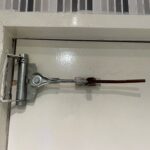UPDATE: As of October 4, 2012, UL has reversed this directive. The bulletin can be downloaded here.
I was hoping to hold off on posting anything about this until there was some sort of resolution, but I’m seeing so many emails and discussions I decided to post what I know now, and follow up when I hear more.
As some of you know, UL issued a bulletin on August 2nd, which basically stated that UL labels could no longer be applied to fire rated hollow metal doors less than 32″ wide (nominal), unless the narrower door had specifically been tested. In the past, manufacturers would test the largest unit they intended to label, and the listing would cover any doors up to and including that size. This change means that only doors between 32″ wide and the door width tested would be covered by the listing. Here is the text of that bulletin (or view the bulletin here):
This bulletin is to inform industry of a pending update to the Follow Up Service Procedures (FUSP) for UL, cUL and ULC certified steel swinging type fire doors under the product categories GSYX, GSYX7, GSZN and GSNVC. Wood doors certified under the aforementioned categories are not subject to this update.
A minimum width limit for all swinging type steel fire doors is being established where one does not currently exist. The update will consist of incorporating the following statement into each applicable FUSP Section General:
“The minimum width of the swinging fire door(s) covered by this procedure is not to be less than 32 inches unless there is a specific dimensional reference to a width less than 32 inches.”
UL will initiate a service request to update each FUSP. This work will be done at no cost to you and will be effective immediately upon publication.
We anticipate the FUSP revisions to reflect the minimum door width details will be made over the next two months. To discuss questions specific to your fire doors, please call (email) Matt Schumann at (847)-664-1289 (matthew.schumann@ul.com) or Howard Spice at (416)-288-2248 (howard.spice@ul.com).
Over the last couple of weeks I’ve received many questions and found some answers. I will update the list below as I hear more, so if you have questions or answers to add, leave a comment.
Does this mean that if I order a 28″ wide hollow metal door and need a fire label, the door manufacturer can not apply a UL label? Yes, that is correct, unless the door manufacturer has specifically tested a 28″ wide door.
When does this change go into effect? The change was effective immediately.
Does this change affect Warnock Hersey / Intertek labels? Although I have not seen anything official from Intertek, I have been told that Intertek is not planning to make a change to their label procedures at this time. It does not currently affect Factory Mutual (FM) labels either.
Are wood doors affected? No. Wood doors can be labeled per the established procedures, with no change.
Are single doors and pairs of doors affected? Yes, any door leaf that is less than 32″ wide, whether it is a single door or one leaf of a pair, can not currently be labeled with a UL label unless the manufacturer has specifically tested the narrower door width.
Are frames affected? The UL bulletin addresses hollow metal doors only.
Are all hollow metal door manufacturers required to comply with this change? Yes, this impacts all hollow metal door manufacturers, unless a manufacturer has successfully tested the range of narrower doors. Many manufacturers have sent notices to their customers. The Steelcraft notice is posted here.
What is the reason for this change? This statement is reported to have come from UL: “The change is due to recent information that UL has received that narrower door leaves do not always perform the same way as larger doors. We are currently conducting an internal study to research this topic and will be providing updates to the industry as the project develops.”
Is the change permanent? Will all doors less than 32″ wide need to be retested? If UL’s research successfully proves that the narrower doors DO perform the same way as larger doors, it’s possible that the directive could change, but that is only my speculation. If it turns out that narrower doors DO NOT perform the same was as larger doors, I would assume that the narrower doors need to be retested and possibly redesigned.
Are industry groups working with UL to understand this change? Yes, both the Steel Door Institute (SDI) and the National Association of Architectural Metal Manufacturers (NAAMM) are in close contact with UL and are expecting to hear more within the next few weeks.
What about all of the existing hollow metal fire doors that are less than 32″ wide? Will they perform properly in a fire? Do they need to be replaced? The testing that UL is currently performing will determine the answer to this question.
Let me know if you have additional questions and I will attempt to get answers. Or if you have information to share, everyone who is following this issue would appreciate hearing it.
You need to login or register to bookmark/favorite this content.






Leave A Comment